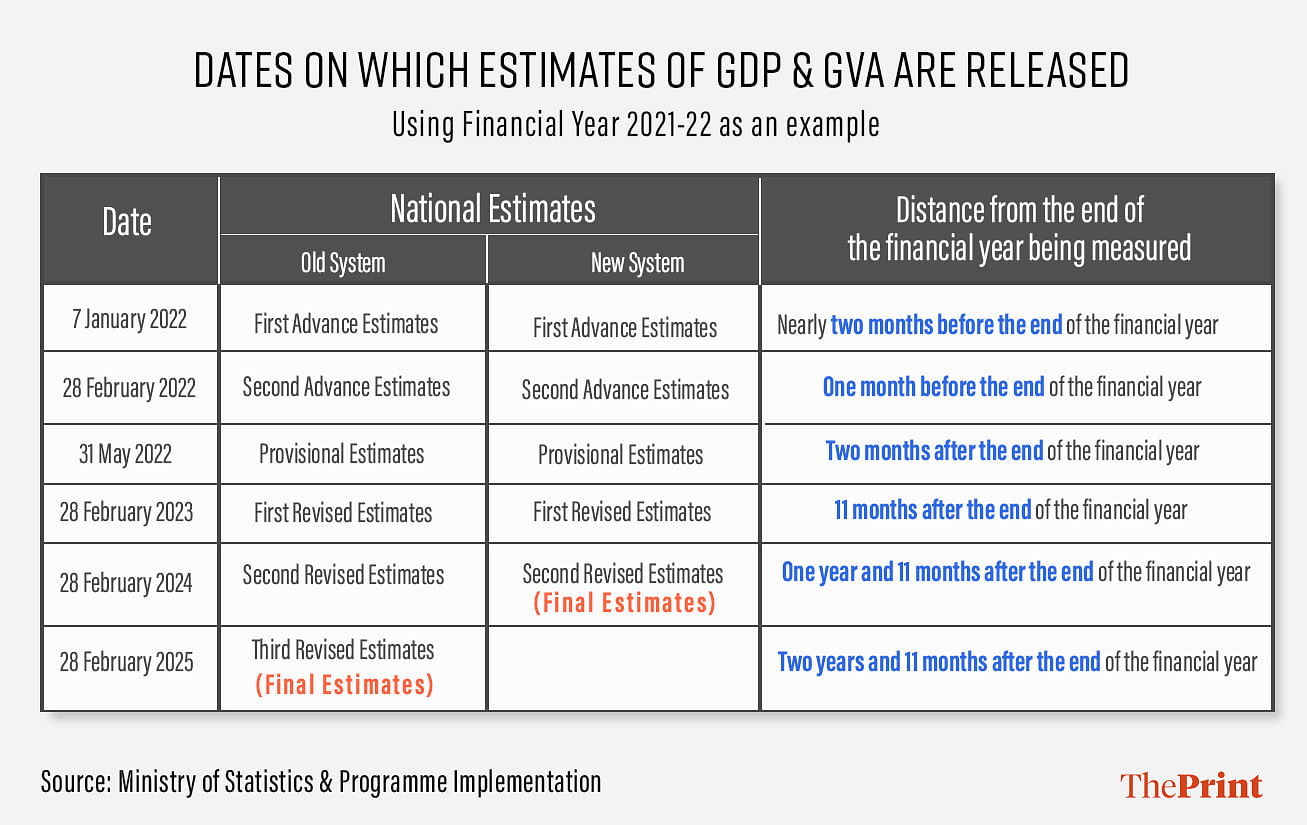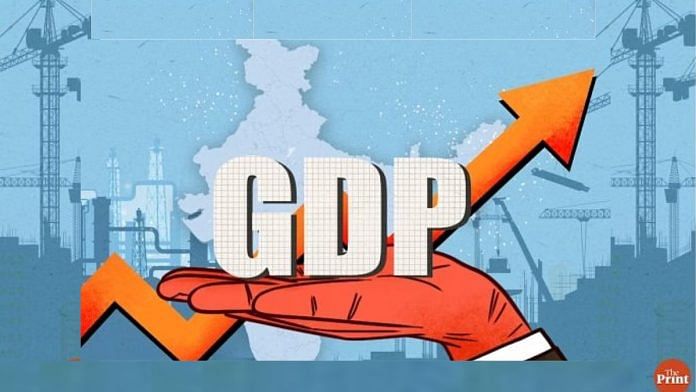New Delhi: Until this year, if policymakers and analysts wanted the final economic growth figures or GDP data for any particular financial year, they had to wait nearly three years after the end of the year in question. Now, the government has reduced this lag to two years — that is, by one-third.
While the decision itself was made public in an unobtrusive and largely unnoticed notification earlier this year, economists and statisticians say it has significant ramifications for policymaking.
ThePrint has also managed to get the Ministry of Statistics and Programme Implementation (MoSPI), which is in charge of releasing this data, to explain how they achieved this shorter timeline.
According to them, it’s the culmination of a longer effort to speed up data gathering at the national level, and a more recent effort to work with state governments to encourage them to provide data in a more timely manner.

The decision reduces the number of estimates the government puts out for GDP growth to five from the previous six. These six estimates ranged from the first revised estimates released around two months before the end of the financial year being measured, to the third revised estimates released nearly three years after the end of that financial year.
In a notification issued in February 2024, MoSPI announced that, in consultation with the ministries of planning and corporate affairs, it had decided that the second revised estimates of national income, consumption expenditure, saving, and capital formation for 2021-22 would be the final estimates for that year. “It has also been decided to do away with the Third Revised Estimates for the years 2021-22 onward,” the notification added.
To use an example, earlier, final figures for FY2021-22, which ended on 31 March, 2022, would have come out only in 2025. Now, the figures released in February 2024 will be the final ones. This shortened timeline would be followed for all subsequent years.
“This is a welcome initiative,” D.K. Srivastava, chief policy advisor at EY India, said.
“As long as the data remains reliable and there is no compromise on the quality, it will make policymaking easier and more current. Many revisions to the output data and GDP data had resulted in frequent revisions in policy.”
He added that this would give policymakers and commentators a better idea of how the economy has done in the recent past, and also provide a more timely and accurate roadmap for the future.
Also Read: Not only is FDI into India falling, but foreign firms are increasingly taking their money out
GDP data: Criticism drives need for speed
MoSPI, in response to queries sent by ThePrint, said that it had seen that an issue “raised on multiple occasions” was that the government carried out too many revisions and that it was taking three years to finalise GDP estimates.
“What was happening was that there was a lot of criticism saying that we have too many estimates of GDP coming in, which was a legitimate criticism,” Pronab Sen, chairman of the Standing Committee on Statistics, told ThePrint.
In order to address this, MoSPI said it had worked with all related agencies to speed up the data supply and gathering process.
“Though many revisions in GDP estimates are carried out by statistically advanced countries viz. USA, Canada, etc. because of receipt of more datasets at different points of time, MoSPI reviewed its agency-wise data supply matrix and urged upon those data supplying agencies to expedite their process which were (sic) lagging behind,” MoSPI said in a detailed note to ThePrint.
Making states work faster
Sen explained that a large part of the delay, which made the third revised estimates necessary, had to do with the pace at which the states provided MoSPI with the data it needed.
“The big problem used to be the states and, in particular, the state public sector undertakings,” he explained.
“They used to give their data very late, which was further delayed because MoSPI would only accept the audited financial statements. If they have managed to get this speeded up, then that’s a good step.”
According to MoSPI, that is precisely where the improvements have been made.
“Consultations were held with state governments/UT administrations,” MoSPI said. “All the states agreed to provide finalised data at the time of the second revised estimate itself, i.e. one year before the existing timelines.”
The ministry further said it had requested other key ministries to also expedite their data releases, and that it had also sped up the finalisation of its own Annual Survey of Industries (ASI). “Because of these concerted efforts, MoSPI could receive all the datasets before the second revised estimates (SRE) of 2021-22,” the ministry said. It was this that convinced the ministry that it would be possible to do away with the third revised estimates entirely.
Other improvements have also helped
Sen explained that doing away with the third revised estimates was part of a longer process. For example, he said, the Periodic Labour Force Survey (PLFS) was introduced in 2017 as an annual survey of the employment situation, replacing the previous Employment and Unemployment Situation report, which came out once in five years.
“Now, since the PLFS is an annual series on employment, that also helps,” Sen said. “Since it comes with a year’s lag, the second revised estimates can utilise that data, which makes these numbers more robust.”
Previously, this was done once every five years and projections would be required to figure out the annual numbers, he said, adding: “That used to be a problem.”
The annual report of the National Statistical Commission (NSC) also pointed to other improvements relating to estimates for the services sector as well as India’s large unorganised sector.
“During the 108th meeting of NSC held on 19th August 2019, the Commission was informed that the Government had decided to undertake the Annual Surveys of Service Sector Enterprises (ASSSE) and Annual Surveys of Unincorporated Sector Enterprises (ASUSE) on a regular basis on the lines of the Annual Survey of Industries so that there is a better picture about how these sectors contribute to economic development,” the NSC’s 2019-20 report said.
The first ASUSE was for the October 2019-March 2020 period, the second for April 2020-March 2021, and the third for October 2022-September 2023.
None of the data from these surveys have been made public, but Sen said whatever has been gathered will strengthen the national accounts data presented in the second revised estimates for each financial year. “All of this means the second revised estimates will be more robust, and you will now have surety at the time they are released that these numbers are final and will not be revised further,” he said.
(Edited by Uttara Ramaswamy)
Also Read: FM Sitharaman stresses govt’s manufacturing focus at a time when ‘some economists’ advise otherwise



